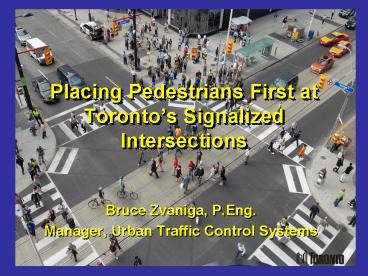Placing Pedestrians First at Torontos Signalized Intersections - PowerPoint PPT Presentation
1 / 20
Title:
Placing Pedestrians First at Torontos Signalized Intersections
Description:
General Characteristics of Toronto's Signal Operation ... unopposed turning movements, and heavy pedestrian movements on conflicting crosswalks ... – PowerPoint PPT presentation
Number of Views:36
Avg rating:3.0/5.0
Title: Placing Pedestrians First at Torontos Signalized Intersections
1
Placing Pedestrians First at Torontos Signalized
Intersections
- Bruce Zvaniga, P.Eng.
- Manager, Urban Traffic Control Systems
2
Outline
- Toronto Context
- Transportation Plan for Sustainable Growth
- Recent Improvements to Pedestrian Signal
Operations - Wish List for Future Improvements
3
Torontos Population
- Population 2.5 Million (5.5 Million in Region)
- One-seventh are over 65 years of age (fastest
growing age group)
4
General Characteristics of Torontos Signal
Operation
- 2100 traffic signal-controlled intersections
- Roughly one-third fixed-time operation and
two-thirds semi-actuated - Transit signal priority at one of every six
intersections - All signalized intersections are connected to
central systems 64 in-house time-of-day, 20
TransSuite and 16 SCOOT
5
Transportation Growth
- 75 growth in both AM inbound and outbound
vehicle flows to entire city over past 20 years - However,
- 66 of inbound trips during the AM to the central
area are by transit the vast majority of these
trips include some walking
6
Transportation Plan for Sustainable Growth
7
Sustainable Transportation Initiatives Summary
Chart
6. TDM Initiatives
7. Other Initiatives
5. Other Transit Improvements
4. Transit Priority
3. Parking
2. Cycling
1. Pedestrians
1.1 Pedestrian Zones and Streets
2.1 Bicycle Stations and Parking
3.1 Extend Peak Hour Parking Restrictions
4.1 Additional Turn Restrictions
5.1 Proof of Payment
6.1 Region-wide SMART Commute
7.1 Time Management for Deliveries
1.2 Pedestrian Enhancements at Intersections
3.2 Off-Street Parking Standards
4.2 Reserved Bus Lanes
5.2 GPS-related Transit Technology
7.2 Educational Programs
2.2 Bicycle Sharing
6.2 Local Employer- Based TMAs
2.3 East-West Bike Route Thru Core
3.3 Peripheral Commuter Parking Lots
4.3 Enhanced Enforcement
5.3 Additional Transit Vehicles to Improve
Service
1.3 Improvements to the Pedestrian Public Realm
7.3 Promoting Taxi Use
6.3 Citys Employee Trip Reduction Program
2.4 Major Bicycle Trail Corridors
7.4 Review of HOV Lanes
1.4 Pavement Narrowings
6.4 Car Sharing
7.5 Intelligent Transportation Systems
1.5 Green Corridors to the Waterfront
Short Term (0 - 2 years)
Medium Term (3 - 5 years)
Long Term (5 years)
6.5 Road-User Charges
May Require Metrolinx Support, Coordination or
Funding
8
Pedestrian Countdown Timers
- Addresses confusion/uncertainty
- Council approved 3 year city-wide implementation
to be completed June 2009 concurrent with LED
Conversion - Countdown of clearance (flashing dont walk)
phase only - Issues with variable clearance timing where
rail, fire hall, and transit pre-emption present - Public, political, media and police reaction very
positive
9
Leading Pedestrian Interval
- 4 second headstart for pedestrians before vehicle
green - Status
- Removed quickly at normal intersection
- Retained and highly successful at intersection of
one-way street with heavy left-turning traffic to
a two-way street - Plan is to try another 5 to 10 locations in
2009 - looking for intersections with similar
unopposed turning movements, and heavy pedestrian
movements on conflicting crosswalks
10
Accessible Pedestrian Signals(aka audible
pedestrian signals)
- Council policy decision to include APS at all new
traffic signal installations and to target
retrofits within a year of receiving a request. - 250 intersections currently equipped
- 60 additional retrofits targeted in next 2 years
- Questions remain about how to handle complex
intersection geometrics
11
Increased Pedestrian Crossing Time
- Old method
- Walk speed 1.2 m/s or 1.0 m/s
- Ped clearance was timed for 5/8ths of the minimum
total time - New method
- 7 second minimum walk, full clearance distance at
1.2 m/s walk speed walk plus clearance time
must allow for 1.0 m/s walk speed - New method only applied after installation of
countdown timers - Impact on transit priority infrastructure due
to relationship between loop detector placement
and time to decision point somewhat less
efficient
12
Pedestrian Signal Priority
- Barnes Dance
- Exclusive Pedestrian Phase
- Pedestrian Scramble
13
Pedestrian Signal Priority Perceived
Benefits
- Clear message that pedestrians are important
- Increase pedestrian comfort level
- (May) improve safety
- Low cost, easy to implement ?
14
Pedestrian Signal Priority Challenges
- APS
- PCS
- Signs Markings
15
Pedestrian Signal Priority Blind and
Visually Impaired Peds
- Issue of audible tone
- Walk Sign is on for all crossings
- Concerns expressed about confusion
- Lack of parallel traffic sound
- How does a visitor detect the difference ?
- Confusing for guide dogs who do you follow
- Need for tactile way finding
- Concern about crowding around APS buttons
- Lack of distinct north-south vs. east-west tones
16
Pedestrian Signal Priority Countdown Signals
Display
- Issue caused by concurrent and priority phasing
- PCS count down the clearance time
- Crossing clearance on the diagonal is greater
than the orthogonal - PCS devices use simple logic count down time
based on the previous display time
17
Pedestrian Signal Priority Signs
- Signs
- To sign or not to sign
- Are the signals intuitive or susceptible to
misinterpretation? - Markings
- Full diagonal or stub
18
Pedestrian Wish List for Traffic Signals
- Pedestrian Detection SAP SAC issue
- PII pedestrian infrastructure integration .
low cost handheld device using DSRC to
communicate information to peds (particularly
visually-impaired)
19
For Further Information
- Bruce Zvaniga
- Manager, Urban Traffic Control Systems
- City of Toronto Transportation Services
- 703 Don Mills Road, 5th Floor
- Toronto, Ontario, Canada
- M3C 3N3
- Phone 416-392-8826
- E-mail bruce_zvaniga_at_toronto.ca
- http//www.toronto.ca
20
(No Transcript)































